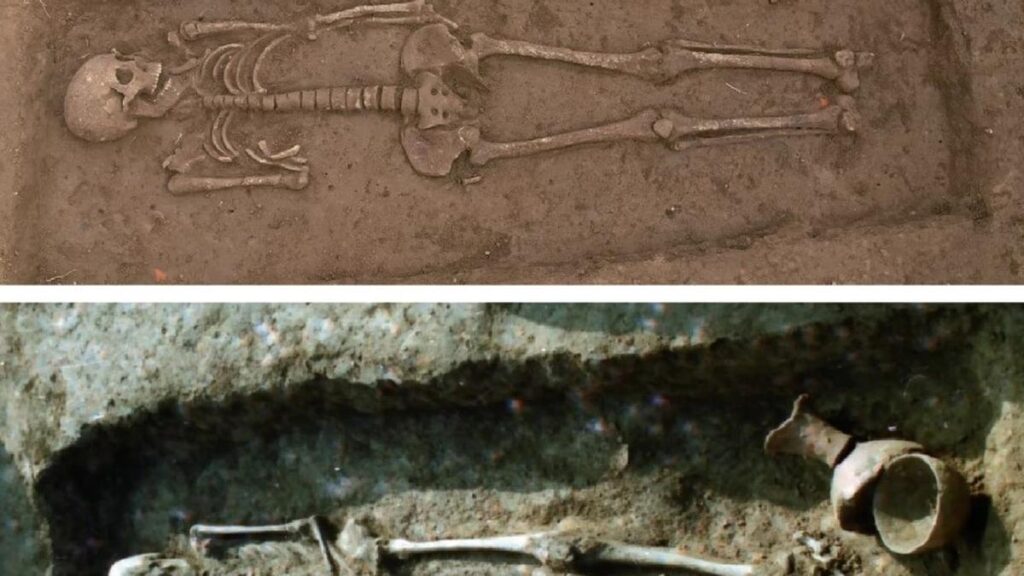
Human remains found in the northern grave (top) and in the southern grave (bottom) at the Neolithic site in Fujia, China.
| Photo Credit: Ning, et al. (2025)
Evidence from two Neolithic cemeteries on China’s eastern coast, reported recently by researchers at Peking University in Beijing in Nature, showed that some communities were organised in matrilineal clans 4,750-4,500 years ago.
Scientists are still debating whether any early human societies were matrilineal. Numerous genetic studies have concluded ancient societies were patriarchal. Some of the rare exceptions include the Chaco Canyon dynasty in North America (800-1300 BC) and some Celtic communities in Germany (616-200 BC).
The new evidence came from analysing skeletal remains retrieved from cemeteries used for around 250 years, spanning at least 10 generations. The findings challenge scientists’ assumptions about traditional societies.
Most of an individual’s genome (DNA) is inherited equally from each parent. But around 0.0005% is inherited only from the mother. This is the mitochondrial DNA (mtDNA). Sperm cells don’t normally transmit mitochondria. The non-mtDNA is located in the cell’s nucleus. Nuclear DNA contains two genome sets and is organised in 23 pairs of chromosomes. One chromosome of each pair is inherited via the father’s sperm and the other via the mother’s egg. The sex chromosomes, X and Y, define one pair.
Both males and females inherit an X chromosome from the mother. Females receive their second X from the father, whereas males receive the Y chromosome that carries the maleness-determining gene. The Y chromosome carries about 1% of the nuclear DNA. Since the Y is transmitted by a father to all of his sons, it is patrilineally inherited.
Thus, sequence information from mtDNA and Y-chromosome is used to trace maternal and paternal lineages, respectively.
Isotope ratios
The researchers found all individuals buried in each cemetery had the same mtDNA but the mtDNA in the two cemeteries was different. In contrast, the Y chromosomes recovered from the male remains were diverse, meaning in each cemetery the burials were determined solely by matrilineal affinity.
Analyses of the rest of the genome revealed frequent intermarriages between relatively distantly related individuals across the two matrilineal clans, such as second or third cousins. Two particular individuals interred in different cemeteries, N01 and S32, were a paternal aunt-nephew pair or a niece-paternal uncle pair. Their mtDNA was consistent with where they were buried. This adherence to matrilineal burial was also evident in two pairs of first-cousins.
Each geographical locale has a characteristic ratio of the 87Sr isotope to that of the 86Sr isotope, depending on the mineral composition of the local soil. The ratio in teeth indicates the individual’s childhood location while that in bones their adulthood location. If the ratios in teeth and bone differ, the individual may have migrated. The bones and teeth of the remains had the same Sr ratio as local wild plants, meaning the individuals were born and resided throughout their lives in the same geography. Similarly, the ratio of carbon isotopes 13C to 12C indicated a diet dominated by corn, sorghum, millet, sugarcane and switch-grass.
The researchers concluded the population practiced millet-based agriculture and raised pigs for meat. Males and females had the same diet.
The findings exemplify how anthropology and archaeology are furthered by studying genomes and isotopes. Agriculture, animal domestication, and settled communities began in the Neolithic period. That cemeteries from this time were organised around matrilineal clans suggests the existence of a matrilineal society in early human history.
D.P. Kasbekar is a retired scientist.
Published – July 02, 2025 07:30 am IST

